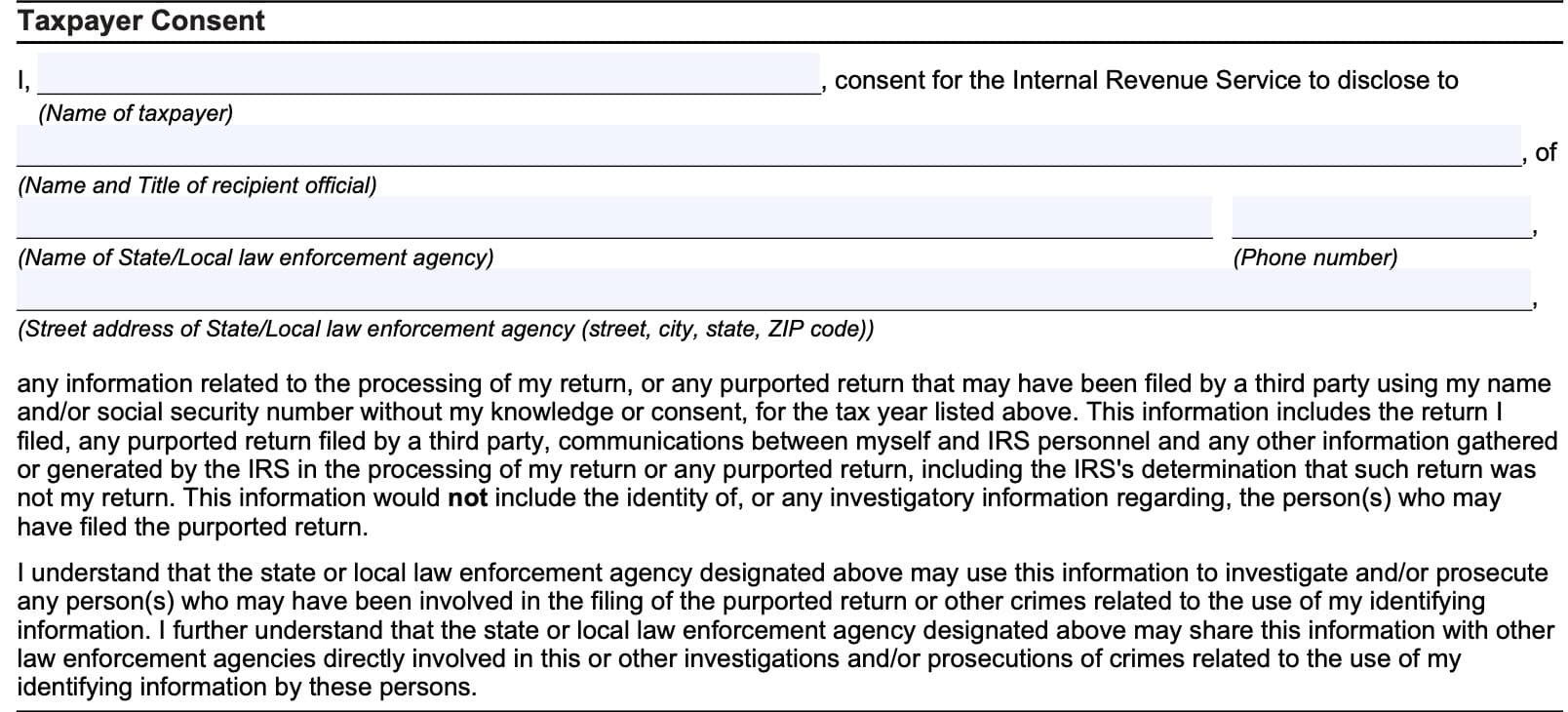IRS Form 8821-A Instructions
If you believe that your Social Security number or tax information was used to file a fraudulent tax return, the Internal Revenue Service may ask you to complete and sign IRS Form 8821-A, IRS Disclosure Authorization for Victims of Identity Theft. This tax form allows the IRS to release certain tax information to state and local law enforcement agencies investigating related crimes.
In this article, we’ll go over IRS Form 8821-A, including:
- How to complete and file IRS Form 8821-A
- Filing considerations
- How IRS Form 8821-A is used
- Frequently asked questions
Let’s start with a step-by-step guide on completing this tax form.
Contents
Table of contents
How do I complete IRS Form 8821-A?
This one-page tax form is relatively straightforward. For your convenience, we’ve broken down IRS Form 8821-A into three parts:
- Taxpayer information
- Taxpayer consent
- Taxpayer signature
Let’s take a closer look at each, beginning with the taxpayer’s information fields at the top.
Taxpayer information
At the top of IRS Form 8821-A, you’ll need to enter the following essential information:
- Taxpayer name
- Social Security number
- Daytime telephone number
- Mailing address, including city, state, and zip code
- Tax year for which you believe your tax return was filed
- For additional past year returns, you’ll need to complete a separate Form 8821-A for each specific tax return
Once you’ve completed these fields, we can proceed to the consent portion of the form.

Taxpayer consent
In this section, you will specify the third party or parties to whom you are giving permission to access your confidential tax information.
But before we do, let’s take a couple of minutes to better understand the fine print in this section.
What am I consenting to?
By filing Form 8821-A, you are allowing the Internal Revenue Service to disclose the following confidential information:
- Any information that is related to the processing of the federal tax return
- Information filed by a third party using your name and Social Security number without your permission
This information includes the following:
- Any federal tax returns that you filed
- Any tax returns that third parties might have filed without your permission
- Communications between yourself and IRS employees
- Including acknowledgements of a fraudulent tax return
This information does not include any information regarding the person who may have illegally filed the tax return or any investigation-related information about that person.
In this form, you also state that you understand that the state or local law enforcement may do the the following with your tax information:
- The state or local law enforcement agency may use this confidential tax return information for investigation or prosecution purposes, either in filing the fraudulent return or other crimes related to your confidential information
- Share this tax information with other law enforcement agencies that are directly involved in this or other investigations and prosecutions of crimes committed using your identity information.
Now that we understand how this form allows for the sharing of tax inofrmation, let’s complete Form 8821’s Taxpayer Consent section.

Name of taxpayer
Enter your complete name in this field.
Name and title of recipient official
Enter the name and title of the specific individual. This is the person to whom you are allowing the IRS to give confidential tax information.
Name of state or local law enforcement agency
Enter the name of the law enforcement agency who is requesting this tax information from the Internal Revenue Service.
Street address of state or local law enforcement agency
Enter the law enforcement agency’s address, including street, city, and zip code.
Taxpayer signature
At the bottom of this form, you will sign to certify that you are the taxpayer whose identity information was used to file the tax return or purported return.
If you are not the taxpayer, then you are signing to certify that you have authorization to sign this form or participate in federal tax matters on the taxpayer’s behalf.
Sign and date the form, then enter your printed name in the space below the signature. If you have an official title, enter that information in the field provided.

Let’s go over some filing considerations regarding IRS Form 8821-A.
Filing considerations
From the form instructions, here are some things to keep in mind about this tax form.
Hard signatures only
The form instructions specifically state that you need to sign in blue or black ink. No electronic signature is allowed.
Only file when requested by a law enforcement agency
According to the instructions, “This form MUST be submitted by IRS Criminal Investigation and/or state or local law enforcement agencies.” In other words, the purpose of this tax authorization form is solely to help law enforcement agencies investigate crimes committed with a taxpayer’s tax information.
Do not sign this form unless requested by the IRS or a law enforcement agency.
Video walkthrough
Frequently asked questions
IRS Form 8821-A, IRS Disclosure Authorization for Victims of Identity Theft, is the tax form that allows the IRS to release information about past tax returns to law enforcement agencies investigating identity theft or other tax-related crimes.
There is no due date for this tax form. However, there is an expiration date. The IRS will not process this form or release tax information if this form is received more than 120 days from the taxpayer’s signature date.
Where can I find IRS Form 8821-A?
You can find tax forms such as IRS Form 8821-A on the IRS website. For your convenience, we’ve enclosed the most recent version of this form here, in this article.


